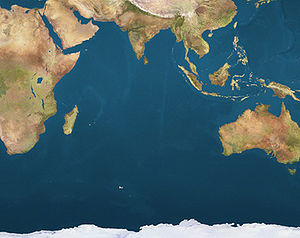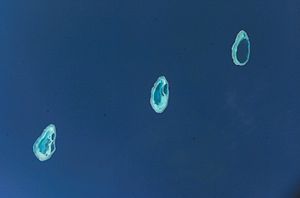- Rowley Shoals
-
The Rowley Shoals is a group of three atoll-like coral reefs south of the Timor Sea, about 260 km west of Broome on the northwestern Australian coast, centered around 17°20′S 119°20′E / 17.333°S 119.333°E, on the edge of one of the widest continental shelves in the world. Each atoll covers an area of around 80 to 90 km² within the rim of the reef, including the lagoons, while the land areas are negligible. They belong to Western Australia. They all rise steeply from the surrounding ocean floor. To the northeast lie the Scott and Seringapatam Reefs which are located on the same undersea platform. The group was named after Captain Rowley, who sighted Imperieuse Reef in 1800. It is believed that the Rowley Shoals reefs have been visited by fishermen from Indonesia, from at least the mid-18th century. The fishermen were also collecting or hunting for Trepang (holothurians or sea cucumbers), turtle shell, trochus shell and shark fin.
These early visitors apparently knew the Rowley Shoals as Pulau Pulo Dhaoh. In later years, fishermen from Roti Island, south of Timor, also visited the Rowley Shoals, which they knew as Pulau Bawa Angin. The individual reefs were also given names, Mermaid being called Pulau Manjariti, Clerke Reef was Pulau Tengah and Imperieuse Reef was Pulau Matsohor.
- Mermaid Reef, the northeastern one of the three reefs at 17°06′S 119°37′E / 17.1°S 119.617°E, is an atoll with a large lagoon enclosed by a rim of coral, which falls dry. There are many drying patches in the lagoon. On the northeast side of the reef, there is a passage, about 60 m wide, leading into the lagoon. Mermaid Reef rises steeply from the surrounding ocean floor, which is 440 m deep. The atoll was named in 1818 by Captain Philip Parker King, who discovered the reef and named it after his ship.
- Clerke Reef (also called Minstrel Shoal), at 17°19′S 119°21′E / 17.317°S 119.35°E, lies about 23 km southwest of Mermaid Reef. The reef has a length of about 15 km north-south, and a width of about 6 km. Near the northern end of the reef lies Bedwell Islet, a bare sand cay about 2 m high. On the eastern and western sides of the reef there are a number of boulders which fall dry. A narrow passage leads to a lagoon, with many detached coral patches within the reef. Clerke Reef rises steeply from the surrounding ocean floor, which is 390 m deep. It was also named by Captain Philip Parker King, after Captain Clerke, who had reported it from a whaler between 1800 and 1809.
- Imperieuse Reef, at 17°35′S 118°55′E / 17.583°S 118.917°E, lies about 35 km southwest of Clerke Reef and is the southwesternmost of Rowley Shoals. It is about 16 km in length north-south and has a width of about 8 km. On the southeastern edge of the reef there are numerous coral boulders, which rise about 3 m above the water mark. Large areas of the reef fall dry at low water and there are two lagoons, which each contain many coral patches within. Cunningham Islet, a small sand cay 3.7 m high and devoid of vegetation, is located close within the northern extremity of the reef, and is surrounded by a small lagoon, 93 m wide. The islet is the location of a lighthouse, Imperieuse Reef Light. Imperieuse Reef rises steeply from the surrounding ocean floor, which is 230 m deep. The reef was also named by Captain Phillip Parker King, after the ship from which it was sighted by Captain Rowley in 1800.
Clerke and Imperieuse Reefs form the Rowley Shoals Marine Park, declared in 1990 and extended in 2004. The park is managed by the Department of Conservation and Land Management (CALM) now known as the Department of Environment and Conservation (DEC) of Western Australia. The nearby Mermaid Reef Marine National Nature Reserve is managed by the Australian Nature Conservation Agency (ANCA) with the assistance of CALM.
Since about 1977 charter boats based from Broome began operating deep sea fishing and diving expeditions to the reefs and seas around. Since this time interest in the area has grown considerably and the Rowley Shoals has achieved a reputation for offering some of the best diving in Australia. The reefs are among the most remote and pristine marine areas in the world.
External links
Further reading
- Berry, P.F. Ed. (1986) Faunal surveys of the Rowley Shoals, Scott Reef, and Seringapatam Reef, North-western Australia Perth, W.A. : Western Australian Museum, Records of the Western Australian Museum. Supplement, 0313-122X ; no. 25. ISBN 0730903400
Categories:- Islands of Western Australia
- Atolls of the Indian Ocean
Wikimedia Foundation. 2010.


